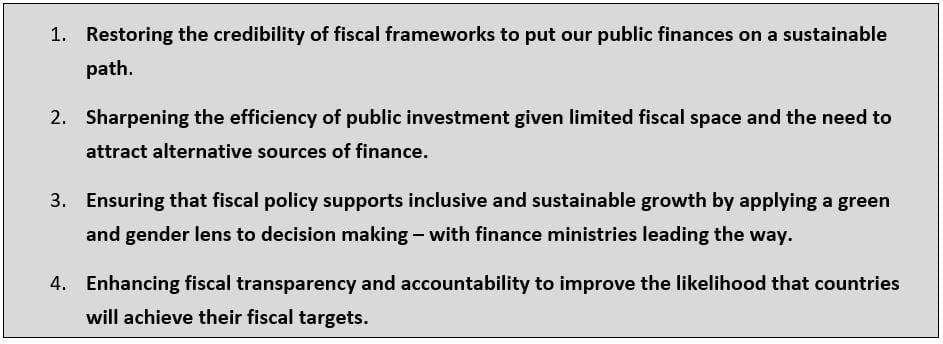Against the backdrop of the food and energy crisis, stubborn inflation, currency depreciations in many emerging market economies and low-income developing countries, slowing growth, and continuing uncertainties, current elevated levels of public debt mean that – to quote the IMF Managing Director Kristalina Georgieva - “2023 is going to be a tough year”[1].
Going forward, debt levels and debt servicing costs are expected to remain high and will impose substantial challenges. In this context, what can countries do to support a sustainable and inclusive recovery by strengthening their PFM institutions?
We all know that robust PFM practices are needed for policies to deliver on intended outcomes. Four practices are key:
1. Restoring the credibility of fiscal frameworks
The pandemic saw many countries take unprecedented fiscal actions to “do whatever it takes - but to keep the receipts”[2]. Some countries activated escape clauses embedded in their fiscal rules. In others, fiscal rules were set aside entirely. As we exit the pandemic, countries should set their public finances on a sustainable medium-term path, recalibrate their fiscal rules, reprioritize expenditure, manage fiscal risks, and rebuild fiscal buffers for the longer term. Fiscal frameworks should be based on realistic revenue forecasts and well-costed expenditure packages. Rigorous evaluation of fiscal policies - where possible through an independent fiscal council - can help enhance and promote the credibility of the government’s fiscal and budgetary policies.
2. Sharpening the efficiency of public investment
Infrastructure gaps globally remain large. Closing them will be critical to support an inclusive recovery and sustainable growth over the longer term. In the context of narrowing fiscal space, ensuring that countries get the biggest bang for their buck from the dollars they spend on infrastructure is critical. IMF research shows that on average 30 percent of expenditure on infrastructure is lost to waste and inefficiency. Countries also need to think about building infrastructure that is climate resilient. The IMF’s new C-PIMA diagnostic tool (the climate module of PIMA) helps integrate climate considerations into the planning, budgeting, and implementation of public investment projects. C-PIMA diagnostics assess countries’ institutional readiness for undertaking and prioritizing climate-friendly investments and guide the selection of appropriate reform measures.
3. Applying a green and gender lens to fiscal decision-making
The IMF has developed a ‘Green PFM framework’ to help countries mainstream climate considerations into the processes, practices, and tools used by governments to prepare their budgets, analyze climate-related risks weighing on their finances, and execute and report on their spending.
In addition, reducing gender disparities goes hand-in-hand with higher economic growth, greater economic stability, and lower income inequality. Policy decisions made by governments can serve to either promote gender equality or reinforce existing inequalities. Gender budgeting entails analyzing fiscal policies and budgets to understand their impact - intended and unintended - on gender equality. Countries can use this information to design and implement effective gender equality policies. Like green PFM, gender budgeting should be integrated into existing budget processes. Critical ingredients for success are an engaged ministry of finance that is firmly in the driver’s seat, a supportive political environment, and binding legislative requirements.
4. Enhancing fiscal transparency and accountability
Research by the IMF and others has demonstrated that fiscal transparency raises the political costs of unsustainable policies, strengthens the enforcement of fiscal rules, improves market access, reduces borrowing costs, and promotes accountability.
As an example, take public debt statistics. In a world where debt levels are high and gross financing needs are large, publishing information on the trends and levels of a country’s debt and its debt management practices are paramount. According to a recent World Bank report, 40% of low-income developing countries worldwide have never published any debt data or have not updated their data in the last two years. When available, many countries’ debt statistics cover only central government loans and securities, omitting subnational governments and public corporations as well as other public sector components and debt instruments. The study estimates that the inclusion of public corporation debt alone would increase the median level of countries’ public debt by more than 7 percent. Without improved transparency on debt and other areas of public finance, the government’s fiscal accountability is weakened, financing costs increase, and fiscal risk assessment is hindered (both inside and outside government).







